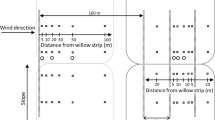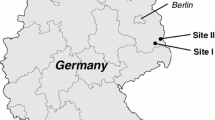Abstract
Tree windbreaks may offer a range of potential advantages in terms of increased crop productivity and stability under climate change while providing multiple external benefits to society. The effects of windbreak on maize yields have not been assessed in a well-documented manner in eastern Canada, which is a major influential barrier limiting their adoption by farmers. In this study, we investigated the spatial distribution of maize grain yield in the leeward side of mature (average age, 30-years-old) single-tree row windbreaks that were located on four farm sites in southern Québec, Canada. We determined whether the sign and magnitude of windbreak effects on spatial patterns of maize yield varied across contrasting years with respect to rainfall conditions. The greatest yield variation was observed at the tree-crop interface (within 0.5–1H, where H = tree height), where substantial yield reductions occurred. In two sites, the magnitude of negative windbreak effects on maize yield at the tree-crop interface decreases in the wetter years. We found important maize yield variation among sampling positions between 2H and 20H (here considered as the shelter zone), with yield values often significantly higher than at 24H (here considered as a control zone with negligible tree shelter effects). The magnitude of this yield variation in the shelter zone generally decreased in the wetter years. In most cases, we estimated that the net effect of windbreak on maize yield (0.5–20H vs. 24H) was negligible. Significant net positive (16 %) or negative (−6 %) effects of windbreaks on maize production were found at one site only and occurred on two different years. We conclude that the sign and magnitude of windbreak effects on spatial patterns of maize grain vary considerably across farms and depend upon temporal variation in rainfall conditions in eastern Canada.


Similar content being viewed by others
References
Almaraz JJ, Mabood F, Zhou X, Gregorich EG, Smith DL (2008) Climate change, weather variability and corn yield at a higher latitude locale: Southwestern Quebec. Clim Chang 88:187–197
Armbrust DV (1982) Physiological responses to wind and sandblast damage by grain sorghum plants. Agron J 74:133–135
Baldwin CS (1988) The influence of field windbreaks on vegetable and specialty crops. Agric Ecosyst Environ 22(23):159–163
Brandle JR, Hodges L, Zhou XH (2004) Windbreaks in North American agricultural systems. Agrofor Syst 61:65–78
Brandle JR, Tyndal J, Sudmeyer RA, Hodges L (2009) Windbreak Practices. In: Garrett HE, Rietveld WE, Fisher RF (eds) North American agroforestry: an integrated science and practice. American Society of Agronomy, Madison, pp 75–104
Centre de Référence en Agriculture et Agroalimentaire du Québec (CRAAQ) (2000) Guide des pratiques de conservation en grandes cultures [Guide for Conservation Practices in Field Crops, in French]. Centre de Référence en Agriculture et Agroalimentaire du Québec, Québec
Centre de Référence en Agriculture et Agroalimentaire du Québec (CRAAQ) (2010) Guide de reference en fertilization [Reference Guide for Crop Fertilization, In French], 2nd edn. Centre de Référence en Agriculture et Agroalimentaire du Québec, Québec
Cleugh HA (1998) Effects of windbreaks on airflow, microclimates and crop yields. Agrofor Syst 41:55–84
Cleugh HA, Prinsley R, Bird PR, Brooks SJ, Carberry PS, Crawford MC, Jackson TT, Meinke H, Mylius SJ, Nuberg IK, Sudmeyer RA, Wright AJ (2002) The Australian National windbreaks program: overview and summary of results. Aust J Exp Agric 42:649–664
Cutter BE, Coggeshall MV, Phelps JE, Stokke DD (2004) Impacts of forest management activities on selected hardwood wood quality attributes: a review. Wood Fiber Sci 36:84–97
Ding S, Su P (2010) Effects of tree shading on maize crop within a poplar-maize compound system in Hexi Corridor Oasis, northwestern China. Agrofor Syst 80:117–129
Easterling WE, Hays CJ, Easterling MM, Brandle JR (1997) Modeling the effect of shelterbelts on maize productivity under climate change: an application of the EPIC model. Agric Ecosyst Environ 61:163–176
Environment Canada (2014a) The national climate data and information archive. www.climate.weatheroffice.ec.gc.ca. Accessed 15 June 2014
Environment Canada (2014b) Homogenized Wind Speed Data Access. https://www.ec.gc.ca/dccha-ahccd/default.asp?lang=En&n=71CB3873-1. Accessed 21 October 2014
Grado SC, Hovermale CH, St. Louis DG (2001) A financial analysis of a silvopasture system in southern Mississippi. Agrofor Syst 53:313–322
Helmers GA, Brandle J (2005) Optimum windbreak spacing in Great Plains agriculture. Great Plains Res 15:179–198
Hou QJ, Brandle J, Hubbard K et al (2003) Alternation of soil water content consequent to root-pruning at a windbreak/crop interface in Nebraska, USA. Agrofor Syst 57:137–147
Howden SM, Soussana JF, Tubiello FN, Chhetri N, Dunlop M, Meinke H (2007) Adapting agriculture to climate change. PNAS 104:19691–19696
Jose S, Gillespie AR, Pallardy SG (2004) Interspecific interactions in temperate agroforestry. Agrofor Syst 61:237–255
Kort J (1988) Benefits of windbreaks to field and forage crops. Agric Ecosyst Environ 22(23):165–191
Kulshreshtha S, Kort J (2009) External economic benefits and social goods from prairie shelterbelts. Agrofor Syst 75:39–47
Lin CH, McGraw RL, George MF, Garrett HE (1999) Shade effects on forage crops with potential in temperate agroforestry practices. Agrofor Syst 44:109–119
Marchand PP, Masse S (2008) Issues related to the development and implementation of afforestation and agroforestry technologies for energy biomass production: results of focus group sessions in Quebec and the Prairie provinces. Natural Resources Canada, Canadian Forest Service, Laurentian Forestry Centre, Quebec City (QC). Information Report LAU-X-135
Miller AW, Pallardy SG (2001) Resource competition across the crop-tree interface in a maize-silver maple temperate alley cropping stand in Missouri. Agrofor Syst 53:247–259
Motha RP, Baier W (2005) Impacts of present and future climate change and climate variability on agriculture in the temperate regions: North America. Clim Chang 70:137–164
Nuberg IK (1998) Effect of shelter on temperate crops: a review to define research for Australian conditions. Agrofor Syst 41:3–34
Plante PM, Rivest D, Vézina A, Vanasse A (2014) Root distribution of different mature tree species growing on contrasting textured soils in temperate windbreaks. Plant Soil 380:429–439
Pretty J, Sutherland WJ, Ashby J, Auburn J, Baulcombe D, Bell M, Bentley J, Bickersteth S et al (2010) The top 100 questions of importance to the future of global agriculture. Int J Agric Sustain 8:219–236
Rey Benayas JM, Bullock J (2012) Restoration of biodiversity and ecosystem services on agricultural land. Ecosystems 15:883–899
Reynolds PE, Simpson JA, Thevathasan NV, Gordon AM (2007) Effects of tree competition on corn and soybean photosynthesis, growth, and yield in a temperate tree-based agroforestry intercropping system in southern Ontario, Canada. Ecol Eng 29:362–371
Rivest D, Cogliastro A, Vanasse A, Olivier A (2009) Production of soybean associated with different hybrid poplar clones in a tree-based intercropping system in southwestern Québec, Canada. Agric Ecosyst Environ 131:51–60
Schoeneberger M, Bentrup G, de Gooijer H, Soolanayakanahally R, Sauer T, Brandle J, Zhou X, Current D (2012) Branching out: agroforestry as a climate change mitigation and adaptation tool for agriculture. J Soil Water Conserv 67:128–136
Strong NA, Jacobson MG (2005) Assessing agroforestry adoption potential utilizing market segmentation: a case study in Pennsylvania. Small-Scale For Econ Manage Policy 4:215–228
Sudmeyer R, Flugge F (2005) The economics of managing tree–crop competition in windbreak and alley systems. Aust J Exp Agric 45:1403–1414
Sudmeyer RA, Hall DJM, Eastham J, Adams MA (2002) The tree–crop interface: the effects of root pruning in southwestern Australia. Aust J Exp Agric 42:763–772
Tartera C, Rivest D, Olivier A, Liagre F, Cogliastro A (2012) Agroforesterie en développement: parcours comparés du Québec et de la France. For Chron 88:21–29
Thevathasan N, Gordon AM, Bradley R, Cogliastro A, Folkard P, Grant R, Kort J, Liggins L, Njenga F, Olivier A, Pharo C, Powell G, Rivest D, Schiks T, Trotter D, Whalen J, Zabek L (2012) Agroforestry research and development in Canada: the way forward. In: Nair PKR, Garrity D (eds) Agroforestry: the future of global land use. Springer, Berlin. Adv Agrofor 9:247–283
Valdiva C, Barbieri C, Gold MA (2012) Between forestry and farming: policy and environmental implications of the barriers to agroforestry adoption. Can J Agric Econ 60:155–175
Zhang H, Brandle JR (1996) Windbreak effect on biomass and grain mass accumulation of corn: a modeling approach. Agron J 88:607–613
Acknowledgments
We would like to thank Stéphane Gariépy and the numerous landowners who have collaborated to this experiment. This study was supported by grants from Agriculture and Agri-Food Canada (AF-10-114, AF-11-155, AF-12-219). We are grateful to Yves Perrault for technical assistance. We thank Drs. William F. J. Parsons and Miren Lorente for their useful comments and for improving the language of this paper.
Author information
Authors and Affiliations
Corresponding author
Rights and permissions
About this article
Cite this article
Rivest, D., Vézina, A. Maize yield patterns on the leeward side of tree windbreaks are site-specific and depend on rainfall conditions in eastern Canada. Agroforest Syst 89, 237–246 (2015). https://doi.org/10.1007/s10457-014-9758-6
Received:
Accepted:
Published:
Issue Date:
DOI: https://doi.org/10.1007/s10457-014-9758-6




